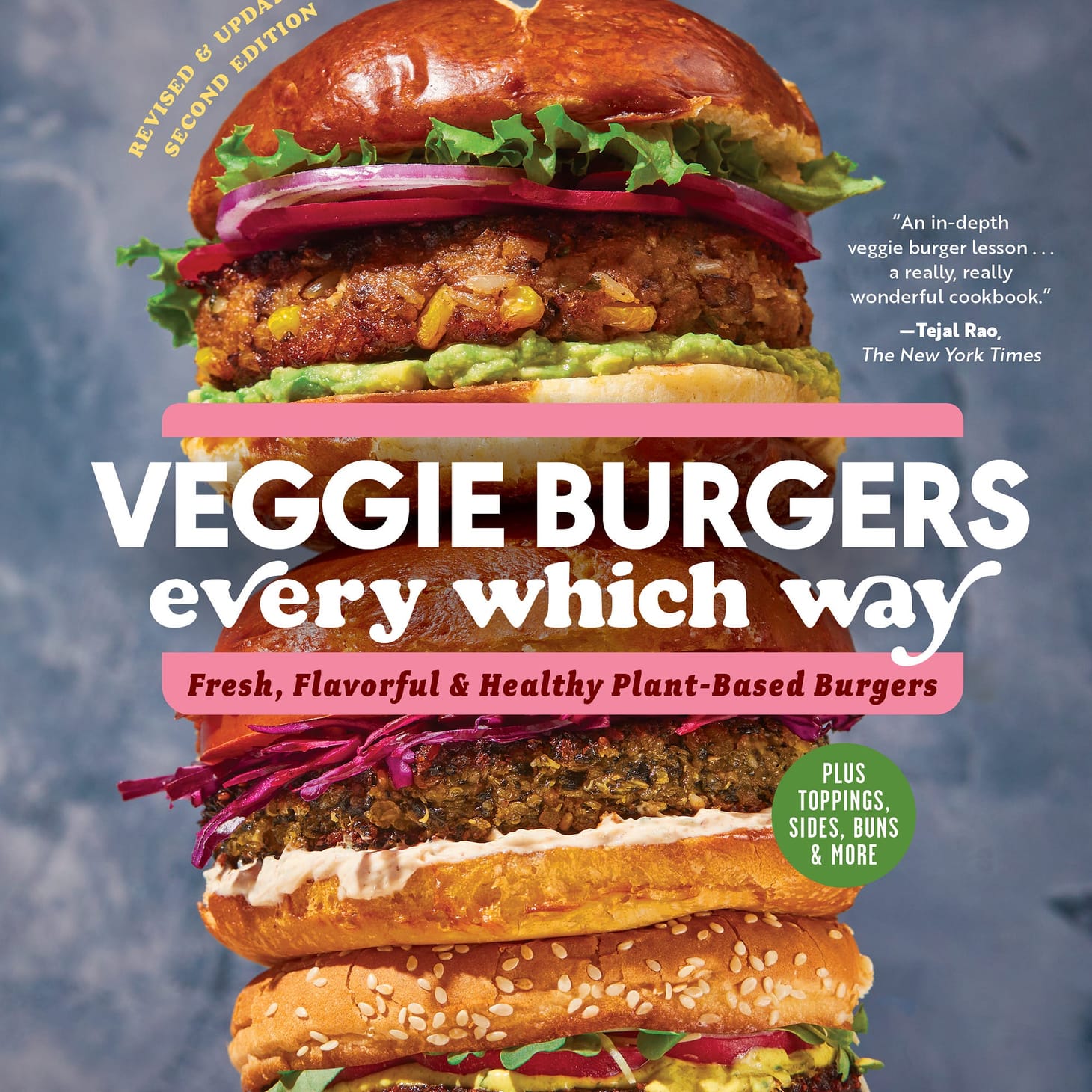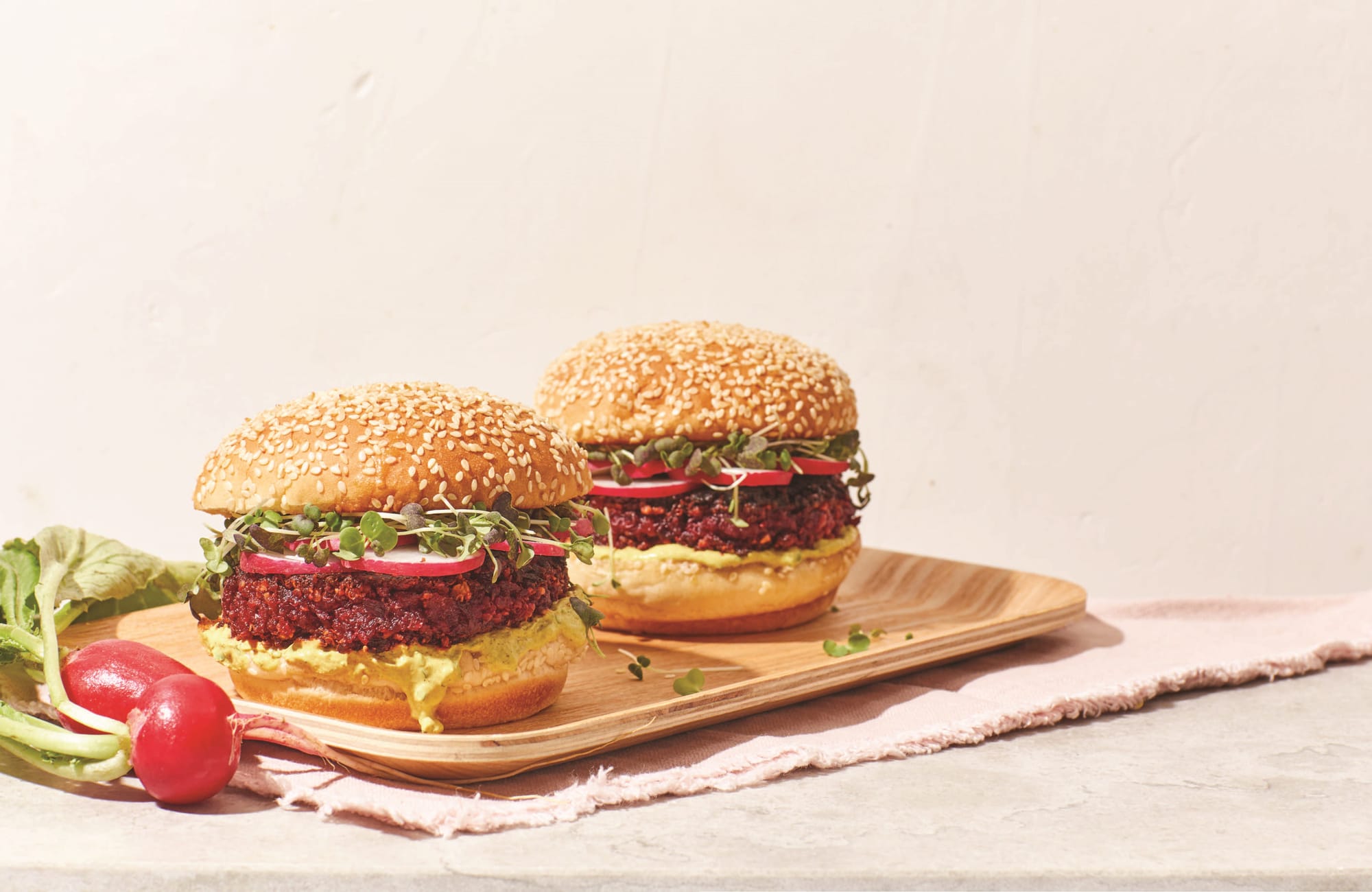Recipe: Beet and Hazelnut Burgers
From Lukas Volger's 'Veggie Burgers, Every Which Way'

Table of Contents
As I’ve mentioned here before, I’m eating mostly vegetarian these days, which means the days of eating (beef) hamburgers are behind me now. I’ve tried Beyond Beef and Impossible burgers and while they are fine in a pinch, they don't really simulate the flavor and texture of a real hamburger enough to justify the expense or the resources that I know go into making them. And while I’ve eaten commercial “veggie” burgers over the years, I’ve always found them lackluster, at best, and dry, starchy, and pasty at worst. The best ones I’ve had have been in restaurants, made from scratch, using fresh ingredients, but these have been rare occurrences. (Rarer now that most places can put an Impossible Burger on the menu to cater to vegetarians and call it a day.)
Which is why I was excited to learn about Lukas Volger’s new (or, more accurately, newly revised and expanded) book Veggie Burgers, Every Which Way, which aims to elevate veggie burgers to a category of their own, without need to compare them to beef burgers, except in name and basic form (a patty, placed between two halves of a bun). Lukas’ introduction spells out the book’s mission:
What can be said now, about veggie burgers, that couldn't have been said in 2010, when the first edition to this book was published? Though veggie burgers were nothing new at that time, it seemed then that they still had something to prove. At my book events and online, I'd have people say, "Call it what you like—but it's not a burger." (I always wondered if these people had the same linguistic bone to pick [pun intended] with lamb burgers, shrimp burgers, salmon burgers, chicken burgers, and bison burgers.) I haven't encountered that line of argument in a while, which I'II take as progress.
More broadly, I could never have predicted that veggie burgers would soon "bleed," or that they'd take hold of the popular imagination that such an innovation would even see the light of day. But here we are, and I truly think it's a good thing. Veggie burgers aren't just a fixture of Western food culture; in many ways they've come to embody the future of food, particularly in terms of how food tech and entrepreneurial efforts are envisioning ways to combat climate change, factory farming, and the ethics of eating meat.
That said, I've never been very excited about a veggie burger that tastes like meat. My perspective in this book was, and continues to be, that veggie burgers should be creative expressions of vegetables1. After all, I'm in this business because I love vegetables, love my local farmers market, and love eating with the seasons. In my view, vegetables should be the star player, and veggie burgers can be a vessel for the flavor of carrots, kale, or beets when they're fresh and delicious, and be presented in a format that's new and unexpected. I don't know about you, but to me that's more fun and also more appetizing.
WBEWW contains 35 recipes for veggie burgers, organized by the main set of ingredients in each: beans and grains, vegetables, and tofu, seitan, tempeh, and TVP. There are also recipes for a handful of from-scratch buns, sides like salads, slaws, and fries, and sauces and condiments. And the long opening section of the book provides instructive guidelines for working with each type of ingredient and techniques, so you can build your own veggie burgers using Lukas’ recipes as a model.
Lukas shared his recipe for Beet and Hazelnut Burgers from the book with us all. I made2 them yesterday for a 4th gathering and they were a big hit, even among the omnivores in the group, and everyone agreed that they were far better than any veggie burger they’d ever had before. I hope you like them too, and that it inspires you to add this excellent book to your collection.
—Andrew

Beet and Hazelnut Burgers

Beet And Hazelnut Burgers Recipe64.6KB ∙ PDF fileDownloadDownload
Vegan/Gluten-Free
Makes six 4-inch (10 cm) burgers
This was the first veggie burger flavor I launched with my company Made by Lukas. I’m very proud of this recipe, which is vegan, gluten-free, full of flavor, and boasts a terrific texture, too. I love the floral flavor of the hazelnuts here, and it’s important to freshly toast them to get the most bang for your buck; in fact, I recommend toasting them well, to a dark, chestnut shade of brown, which will also contribute some pleasantly crunchy texture. And while these burgers taste nothing like meat—they taste like beets! which is the whole idea—the mixture might seem alarmingly red to the unsuspecting guest in your kitchen.
Ingredients
¼ cup (45 g) quinoa, rinsed if not prerinsed
1 teaspoon salt
2 small- to medium-size beets
1 large or 2 medium carrots
4 tablespoons olive oil
1 small onion, diced
1 teaspoon ground cumin
2 cloves garlic
1 tablespoon red wine vinegar
¼ cup (15 g) potato flakes
1 teaspoon cornstarch, potato starch, or arrowroot powder
½ cup (55 g) toasted hazelnuts, finely chopped or ground
- Combine the quinoa with ½ cup (120 ml) water in a small saucepan and bring to a boil. Add ¼ teaspoon of the salt, then reduce the heat to low and cover the pan. Cook gently for 18 to 20 minutes, until the water is absorbed, the grains are tender, and the germ of the quinoa is exposed. Set aside, uncovered, to cool as you prepare the remaining ingredients.
- Scrub the beets and carrots. Trim off the ends and any stringy bits from the beets, but it’s not necessary to peel them. Grate both vegetables using the large holes on a box grater.
Heat 2 tablespoons of the oil in a medium skillet over medium heat. Add the onion, cumin, and the remaining salt, and cook until the onions are softened and beginning to caramelize, about 7 to 10 minutes. Add the garlic, stirring until fragrant, then add the beets and carrots. Cook, stirring periodically, until the vegetables are tender and have concentrated and collapsed a bit, 6 to 10 minutes. Some caramelization and blistering on the carrots and beets is good! Deglaze the pan with the vinegar, using a wooden spoon to scrape any browned bits, then scrape the mixture into a mixing bowl and set aside to cool slightly. - Stir the quinoa into the vegetable mixture, along with the potato flakes, cornstarch, and hazelnuts. Shape into 6 medium burgers.
- To cook (see pages 23–24 for detailed cooking instructions), place a wide skillet over medium heat, and once warm, add the remaining oil. Add as many burgers as will fit comfortably without crowding the pan (usually 3 burgers will fit into a 10-inch/25 cm skillet), and cook until browned and crisped on the bottom, 5 to 7 minutes, then flip and repeat on the other side. The burgers will firm up a bit as they cook, and further once they’re removed from the heat and have cooled slightly. Serve warm.
Recipe from Veggie Burgers Every Which Way, Second Edition: Fresh, Flavorful, and Healthy Plant-Based Burgers—Plus Toppings, Sides, Buns, and More © Lukas Volger, 2010, 2023. Reprinted by permission of the publisher, The Experiment. Available everywhere books are sold. theexperimentpublishing.com
wordloaf Newsletter
Join the newsletter to receive the latest updates in your inbox.




